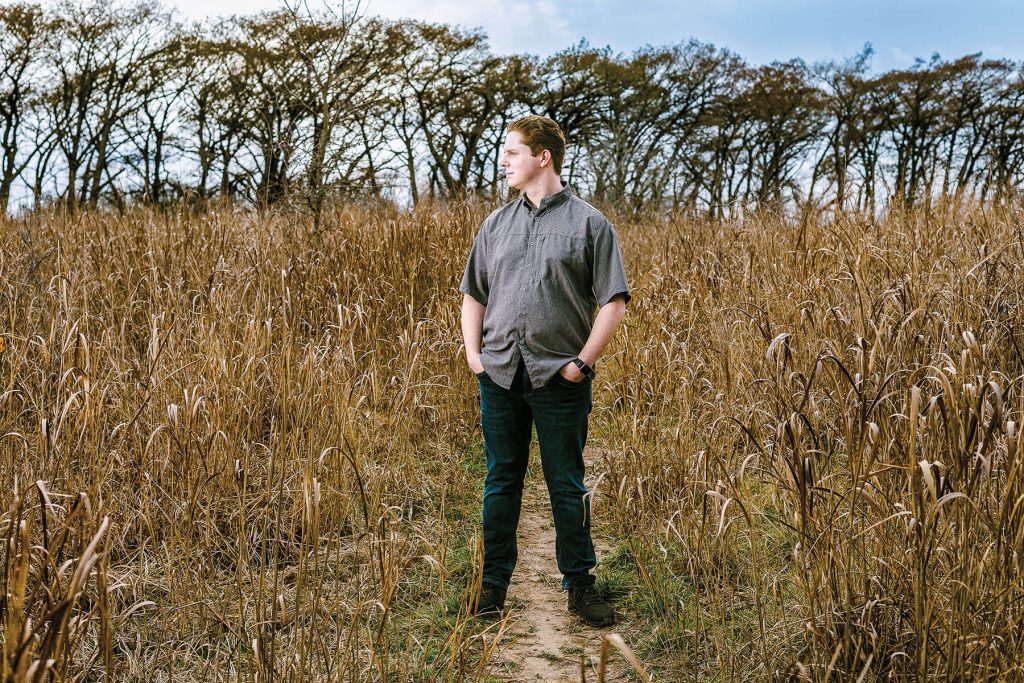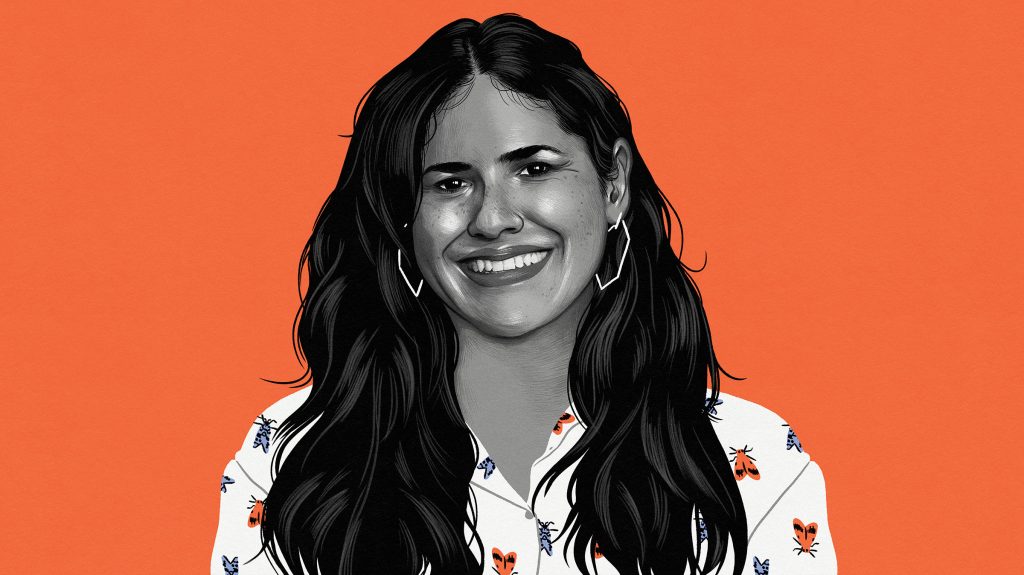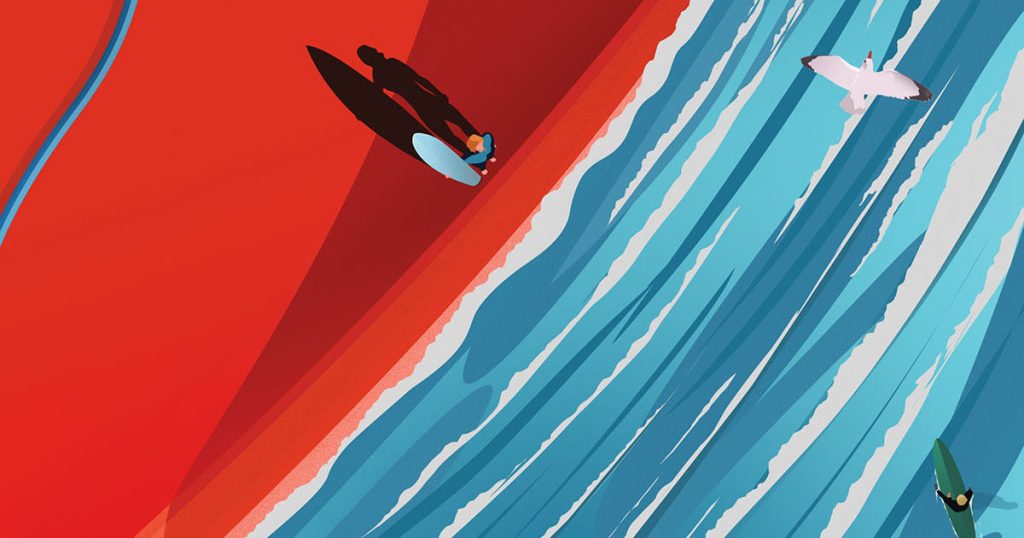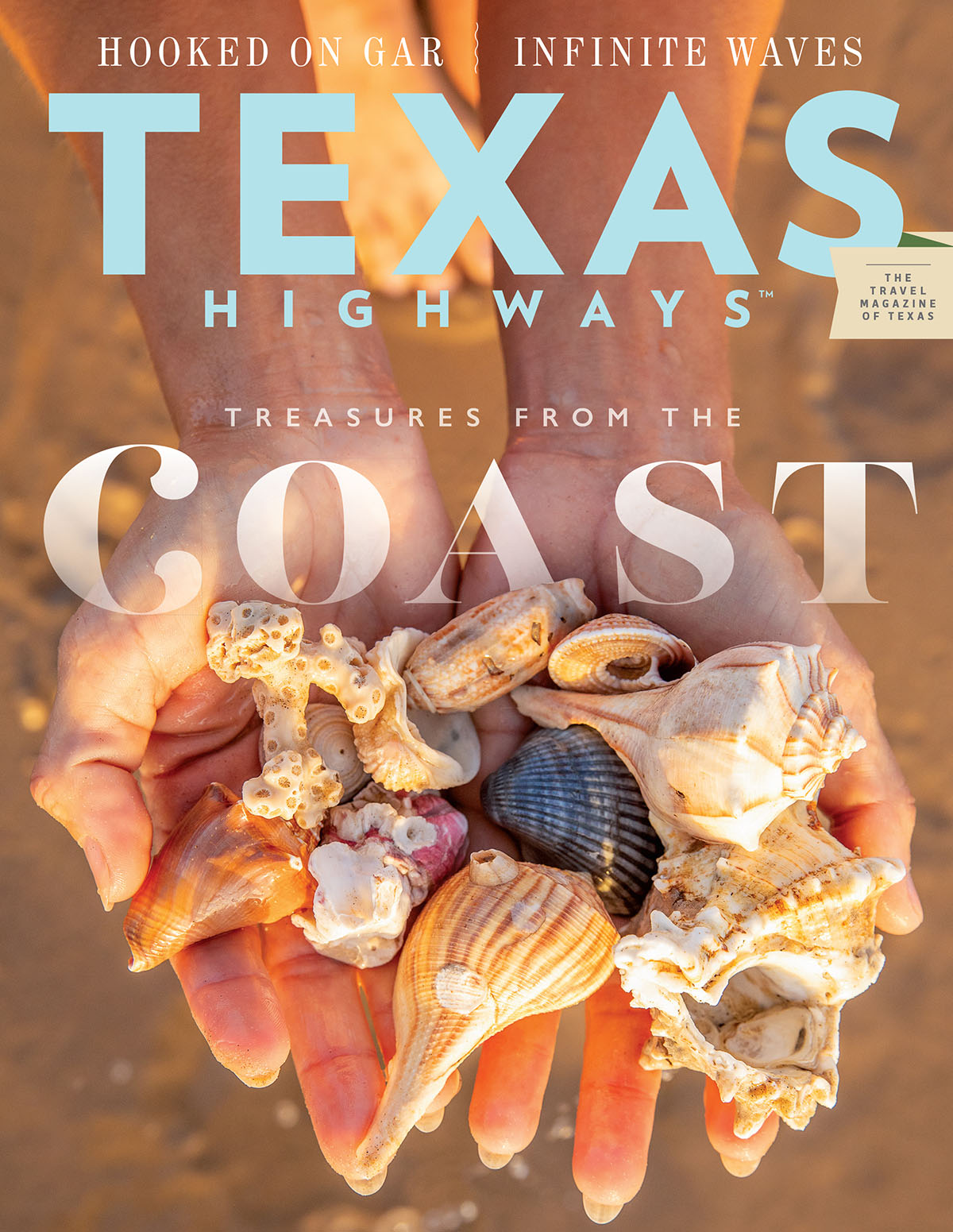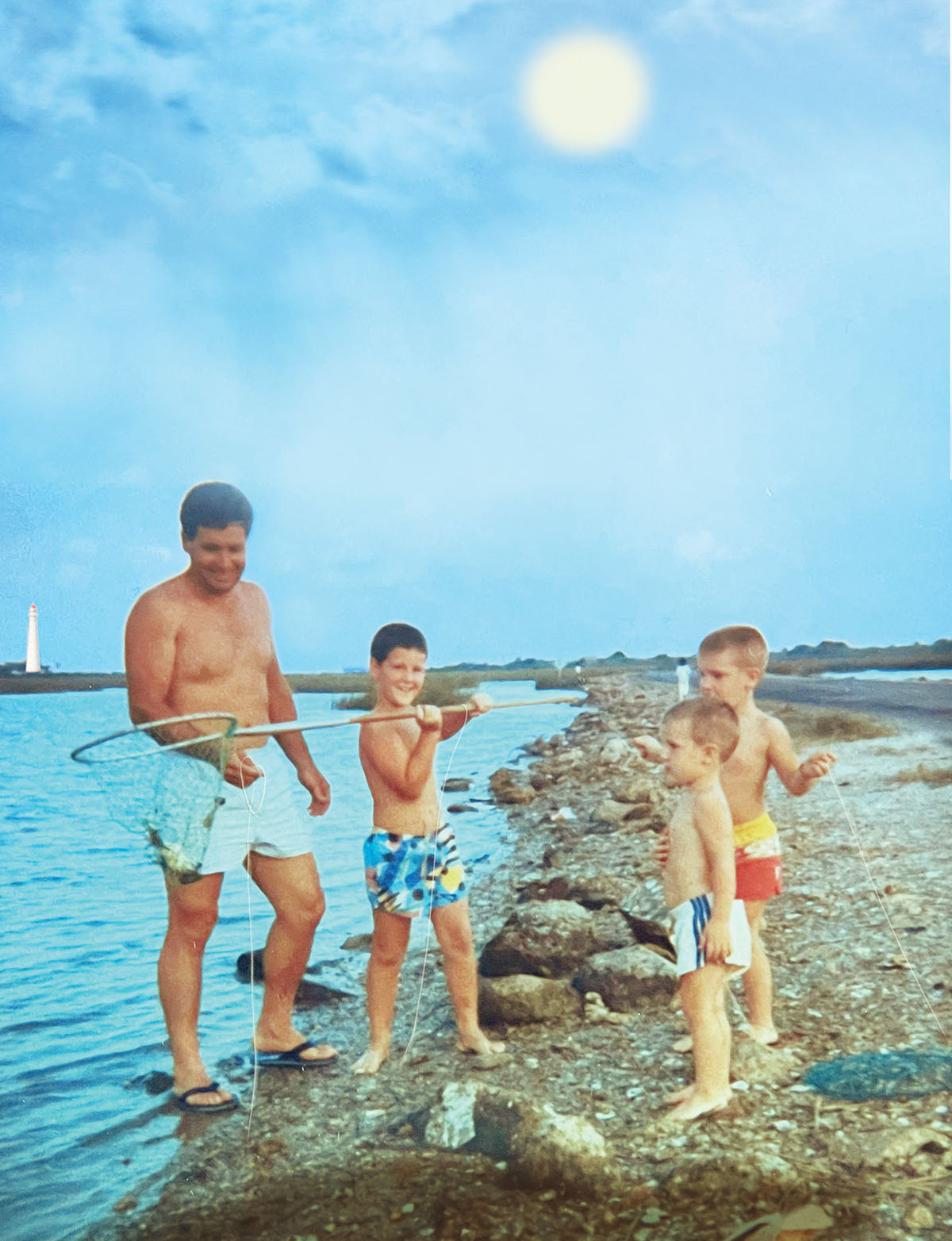
Hard Boiled
A fisherman reels in childhood memories on the Texas coast
by Wes Ferguson
I’m rolling through the produce section, just like any grocery run, when the first whiff of raw fish wafts over from the seafood market. It’s inescapable, that smell, but it passes once you hit the dry goods or salad dressings. This time, I stop short. There, in front of me, is a teeming mass of writhing, clawing, blue-brown crabs in a huge plastic bin. They’re crawling on top of each other, some raising their claws like the fists of wary prizefighters. I live near landlocked Austin, so live ocean creatures are an unexpected sight. But a recollection rises from the depths, as I stand in Fiesta Mart, and suddenly I am 7 years old again.
It was after Labor Day, the start of the offseason on the Texas coast. My parents had pulled me out of school for a getaway to Crystal Beach, a small community on the Bolivar Peninsula, a spit of barrier sand 3 miles east of Galveston. From our home near Kilgore, in East Texas, it had been a long four-hour ride with my two younger brothers in the back seat of our minivan. Somewhere between memory and imagination, the van pulled up to a weather-beaten shack of gray, unpainted lumber set among the sand dunes. Our home away from home teetered on wooden stilts. The floor of the shack was farther off the ground than our treehouse back home. I can still picture the daunting flight of stairs that led inside to a dim, rustic space with old furniture, wide screened windows, and the coconut smell of suntan lotion. Old family photos reveal my brothers and I very much enjoyed digging in the beach sand outside. We splashed in the water and rode the surf on inner tubes.
During our long weekend on the Bolivar Peninsula, my dad taught us to go crabbing on the bay side. On the Texas coast, blue crabs are everywhere. They’re scuttling across the ocean floor, hiding in shallow grass beds, and cannibalizing each other for protein. For bait, it’s common to use a chicken neck tied to a string. A hungry crab grabs hold of the chicken and is disinclined to release its meal, even as it is dragged toward the shore and scooped into a fishing net. If you find the right spot, the process is nearly as easy as gathering manna from heaven.
My family netted enough blue crabs that September day to bring them back to our beach shack, where my parents boiled them with corn and potatoes. I have no memory of eating the crabs, though I’m sure I did. What seems to have clicked for me that day was the realization that I could help put food on my family’s table. The task had been easy and fun. It gave me a sense of satisfaction that has stuck with me for nearly four decades, even though my family never went crabbing again.
My encounter at the grocery store rekindled a long-dormant interest in blue crabs. As an adult, I had tried to boil them a couple of times, with varied results. I’d also done a little crabbing during a campout at Sea Rim State Park, on the Gulf Coast south of Port Arthur. And last spring, my wife, Laura, and I decided on the night before Memorial Day to ring in the unofficial start of summer with a crab boil at our house. We invited our friends Brenda and Terry, and I layered crabs into a huge steel pot I’d purchased long ago to make tamales. Then I turned on the heat and watched as their shells were transformed, almost like magic, from bluish brown to vibrant orange-red.
Brenda grew up in Corpus Christi, and her husband, Terry, is an avid saltwater fisherman, which gave me the false assumption that at least one person at our dinner would know how to eat a crab. Brenda took one from the pile on our kitchen table, futzed with it for a few minutes, set it down, and didn’t touch another. Laura hardly lasted longer. Terry worked his way through a few more before he, too, abandoned the task.
I was the one who’d killed nearly two dozen living creatures for our culinary enjoyment. So, I sat there for another hour, picking, cracking, smashing, ripping, and extracting tiny bits of white flesh.
Our friends never complained, but they did leave hungry. I’m a decent cook, and I pride myself on preparing Texas specialties like brisket and chili. Seafood, a gift to us from the Gulf of Mexico, is no less a part of our state’s cuisine, so my repeated shortcomings preparing it left me feeling frustrated. What had I been missing all these years?
Before I was born, my parents lived for a time in Lafayette, Louisiana, where my dad’s Cajun friends introduced him to crabbing and seafood boils. He also loved to fish. On occasions when his job as a petroleum engineer took him to offshore oil rigs, he told me he spent most of his days on the platform deck, casting into the surf. He taught me and my brothers to use a rod and reel on the lakes and creeks of East Texas. The way I remember it, we spent many afternoons on piers and banks handling slimy worms and hauling in panfish.
Over the years, while writing several articles about Caddo Lake and a book about my hometown river, the Sabine, I discovered a fondness for ramshackle fish camps, where the lazy pace and natural setting gave rise to a sense of community. Never a diehard fisherman, I’m usually content to sit around a fire and hear stories from hard-living old-timers. It had not occurred to me, until recently, that some Texans also have salty old fish camps on the Gulf Coast. I’d been angling for an invite ever since. It came last November.
Under cloudy skies, I rumble over a set of railroad tracks in Liverpool, a speck of a farming community in Brazoria County south of Houston. Seeing a place for the first time always excites me, and I’d never even heard of Liverpool before. Although it was named for the port city in England, there are no shrines to The Beatles as far as I can tell. The town looks very much like other little communities scattered across the rural South—a time-forgotten place with a church, post office, and Dollar General out by the highway. Brahman cattle graze in flat fields. For a mile or two, I am stuck behind a tractor, before I come upon a neighborhood of modest homes built off the ground to protect them from floods, same as the beach shack that had captivated me on the Bolivar Peninsula when I was a kid.
Through a mutual friend, I had asked a veteran chef named David Luna to show me where I’d gone wrong in my previous attempts to acquire and prepare Texas seafood. We’d arranged to meet on Chocolate Bayou, a small, brackish waterway that flows into Chocolate Bay between Alvin and Lake Jackson. “You can always eat out here,” Luna had assured me, “if you sharpen your skills.”
I find chef David, as the locals call him, tending a fire on the banks of the bayou. We are in a grassy clearing next to his friend’s house about 4 miles upstream from the bridge where the bayou and bay intersect. One look at the rich brown color reveals how these bodies of water got their name. Luna, now the director of culinary operations for the Original Ninfa’s Restaurant in Houston, grew up near the bayou and has fished and hung out here all his life.
A Norteño tune, heavy on accordion, plays softly from a portable speaker as Luna feeds onions and lemons into a boiling pot of shrimp and crab stock he’d made at the restaurant and placed into an oak fire. He’s already added leeks, carrots, garlic, and aromatics such as fennel, tarragon, thyme, bay leaves, and epazote for a minty flourish. Luna is preparing a Gulf Coast version of bouillabaisse, a rich and spicy seafood stew traditionally made in the Provence region of France by anglers using scraps from the day’s catch—the original potluck dinner.
“They come back and get one pot going,” he says. “Everyone contributes. ‘I’ve got some squid over here. I didn’t sell this octopus. Throw it in the pot.’” After deglazing with white wine and pouring in diced tomatoes, Luna plans to add shrimp, stone crab claws, and whole blue crabs he and his friends trapped that day, letting it all simmer for five or 10 minutes. “We’ll just go by taste,” he says.
Alex Padilla, a soft-spoken chef who works with Luna, is fishing from the bank that afternoon, but he forgoes the use of a rod and reel. Instead, he unspools some fishing line, baits one end, swings it like a sling, and tosses the line, hook first, into the water. Then, he sets the spool on top of his backpack and watches for movement. Padilla learned this low-cost, low-reward fishing technique from his father, who died in a motorcycle accident when Padilla was 17. “This makes me feel closer to him,” he says.
As sunset approaches, neighbors begin to appear in ones and twos, most bringing along potluck items, from dove poppers to hush puppy batter, to contribute to Luna and Padilla’s cookout. “We’re like the mosquitoes,” one friendly man says as he extends a handshake. “We show up when the sun’s about to go down.”
Padilla pivots from catching to cooking. The night before, he and the others caught several black drum while fishing on the bayou. Padilla fillets the fish but leaves the skin on one side, then grills them over the hot coals. He practices the ancient Mexican zarandeado method, first skin side down till it’s charred, then flipped over just long enough to char the flesh. He serves the fish as tacos with bright spices, fresh pico de gallo, and avocado.
Luna’s bouillabaisse is dished up with crusty bread and the neighbor’s hush puppies. Using the blunt side of a chef’s knife, a third Ninfa’s colleague, Justin Solomon, cracks open the stone crab claws. They weren’t caught fresh but purchased from a local seafood provider named Captain Fred. I’d barely heard of stone crabs, which live along rocky areas and oyster reefs of the Texas coast but are less commonly harvested for food than their blue cousins. To my fascination, I learn that stone crabs are blessed with an enormous pink-and-black “crusher claw” for smashing open oysters. Solomon hands a claw to me. It’s plump, substantial, delicate. It reminds me of lobster and is one of the best things I’ve ever eaten. I reach for another.
The stars are out, and the air is calm. For tonight, I’ve found a community. I am surrounded by friendly Gulf Coast people who are happy to introduce me to their way of life. It’s obvious now that learning to cook seafood was just an excuse.
My younger brothers have kids, and they’re both great dads. I wish they had been old enough to remember our adventures with our father as well as I do.
He surely took us fishing in the Gulf of Mexico at some point, but I have no memory of that. Except for one ill-fated deep-sea excursion with my grandparents when I was a young teen—I vomited all day in the cabin of the ship—I had never even gone saltwater fishing until I was assigned to write several magazine articles on the subject. Those reporting trips, typically accompanied by an expensive guide, were always an adventure, but I never retained enough knowledge about lures, depths, and other angling arcana to have much luck when I subsequently ventured into the salt by myself.
About twice a year, Laura and I drive down to the coast. We try to go once in the winter, when the beaches are empty, the breeze is cool, and oysters and hotel rooms are affordable. We return a second time when it’s warmer for the sun and surf. Although I rarely fish on these excursions, I have a strong sense the Gulf could provide for me, as chef David put it, if I would just sharpen my skills. This feeling was instilled in me on the Bolivar Peninsula. A day cooking seafood over a live fire helps me feel closer to claiming this inheritance.
At the fish camp in Liverpool, night falls. Friends and neighbors pull their camp chairs into a circle around the glowing fire. A few of us load into Solomon’s boat and tool down Chocolate Bayou. I hadn’t realized we were so close to massive chemical plants until their lights begin to shine above the brushy trees on the opposite bank. We come around a bend and are confronted by an enormous tanker docked beside one of the plants. Someone in the tanker shines a spotlight on us and blasts a horn, obviously wishing us to be on our way. Instead, we fish. I catch dozens of black drum and spotted sea trout, none of them keepers. I watch in amazement as the other fishermen put me to shame reeling in impressive drum that will put food on their families’ tables.
Three weeks later, it is dark and cold before dawn as Frederick McBride, also known as Captain Fred, launches his fishing boat into Scott Bay, near the mouth of the San Jacinto River in Baytown. McBride is the commercial fisherman who provided the crab claws for our feast on Chocolate Bayou. Today, he has a different target. With help from his cousin Grant Daniels, he is running seven trotlines for black drum, a meaty fish often served in seafood restaurants. McBride steers the boat toward a buoy marking his first line.
He pulls the buoy into the boat, and Daniels spools the empty line into a bucket. Then McBride feels a familiar tug. “There’s somebody!” he says. “Welcome aboard.” He hoists a seven-pound drum into the boat, followed by another. To my pleasant surprise, the process is like running trotlines on an East Texas river.
McBride, an enthusiastic Houston native thought to be the only Black commercial fisherman on the Texas coast, learned to fish from his grandfather. A classically trained violist, he taught music in a Houston elementary school for nearly two decades before moving on. As of a few years ago, he dedicates himself to fishing full-time. He was good at music, he explains, but he wakes up thinking about fish.
Two hours fly by as the fishermen fill their boat’s built-in cooler with about 200 pounds of black drum—not great by their standards, but a haul in my eyes. Today’s catch is destined for a seafood restaurant owned by celebrity chefs Christopher Haatuft, who is from Norway, and Paul Qui, a Texan. “We gut ’em and take them straight to Golfstrømmen,” McBride says.
I tag along two weeks later as McBride and Daniels run crab traps in Galveston Bay. McBride serves a niche by targeting stone crabs, which fetch a much higher price than blue crabs. Although stone crabs are abundant in Texas, 99% of the nation’s stone crab landings take place in Florida, where stone crabs have a stronger culinary tradition and are better marketed to tourists.
Across the bay, the first orange light of dawn rises to greet an empty sky. Each time McBride pulls alongside a small white buoy, which marks the location of a trap resting on the floor of the bay, Daniels pulls the trap into the boat, where he shakes the catch loose. I hadn’t known to wear rubber boots, and cool water squishes in my tennis shoes. It is a wet and dirty job that can be dangerous. A stone crab’s crusher claw exerts thousands of pounds of pressure per square inch—more than enough to flatten a human finger. Fortunately, crabs operate at a lethargic pace, so I don’t feel at risk.
Daniels expertly pops off the claws and tosses the crabs back into the water, where they will grow a new appendage in a year’s time. I remove the claw from one crab, just to try. I feel the immense strength of the crab’s claws merely having it in my hands, but when I slip a knife into a soft spot on its inner elbow, the claw falls right off. I feel like I’ve unlocked a secret.
Thrilled to be on the water, sharing a small boat with crabbers busy at work, I can’t pretend my dad crossed my mind that morning. Nor do I have other father-son fishing stories to share. He’s been gone a long time, and so many of my childhood memories have faded. But he is also always there, right below the surface, his influence guiding me in ways I’m not conscious of. Even if I will always be a hapless pilgrim on the Gulf Coast, every angler knows that fishing is mostly failure. But we keep casting.
The cousins and I spend a couple of hours on the bay, the sun warming our faces. We finally return to the marina, where McBride surprises me with an expensive gift: two pounds of stone crab claws, resting in seawater, ready for the boil.
Wes Ferguson’s Open Road essay “Ghosts of Pine Island” appeared in the July 2019 issue.

